
If a surfer wears a wetsuit, it’s advisable to thoroughly wash the wetsuit with cold water after being out in the ocean. Regular washing rinses out the salt and preserves the quality of the neoprene material. This routine wetsuit maintenance is accepted as a necessary investment of time in order to maximize the useful lifespan of the equipment.

Similarly, if you’re a surfer, your body requires routine maintenance due to how surfing affects muscles, joints, bones and fascia (connective tissue). Restorative practices including movement, massage and constructive rest are good ways to preserve the useful lifespan of your most irreplaceable equipment: your body.
There are some specific pain points and repetitive stress injuries that my surfer friends here in SoCal regularly complain of. Fortunately, I’ve found that it’s possible for these pains to be reduced or avoided with the right fitness therapy stretches and exercises. I’m offering up a few of those solutions right here today.
Common Surfer Aches and Pains
There is a wide spectrum of how surfing can negatively impact your body. On one side, there’s my friend ‘Stormin Norman’ who has been surfing for years with minimal negative side-effects. His biggest complaint is an occasional cramp in his right ankle or subtle pinching in his lower spine. On the other side, the lower spine pinching can get a lot worse. For some, especially those who already have low back pain outside of the water (like me), surfing can exacerbate the underlying issue.
Take my friend Mitch, whose dormant shoulder injuries and hip asymmetries from years of competitive hockey are often aggravated by surfing. The pain isn’t so bad that it keeps him out of the ocean altogether, but sometimes it’s bad enough for him to end a surf session early. Mitch also deals with the low spine pinching, which I’ve come to realize isn’t unusual among surfers: Every one of the other six surfers I interviewed reported the same lower back pain.
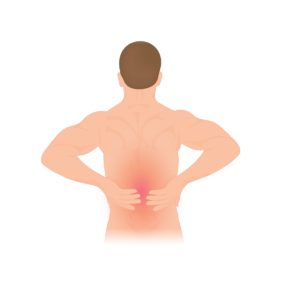
The second most common pain point, on the whole, is the shoulder girdle. This shoulder pain is derived from the repetition of the paddling motion.
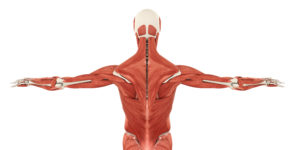
Since my friends’ two biggest musculoskeletal problem areas caused by surfing can both be traced to the repetitive motion of paddling out, rather than the act of surfing itself, I’ll be focusing my recommendations on paddling, as opposed to riding waves.
So what’s the solution to these issues? While there’s no one-size-fits-all answer, there are a handful of principles that can be applied, as well as a few specific exercises that are applicable to most surfers.
Treatment of these aches, pains and imbalances involves restoring softness to overly tight muscles with self-massage techniques on therapy balls. Plus increasing elasticity in muscles/fascia to optimize mobility in the neck, upper back and hips with static and dynamic stretches. It may also be necessary to strengthen the rotator cuff muscles and bring balance to shoulder strength by conditioning weak opposing muscles to paddling.
Pre-Surf Shoulder Stretches
For some, shoulder pain and impingement in the front and side of the shoulders around the deltoid muscles is the most prominent issue. Others report discomfort in the trapezius just below the base of the neck. Also it shows up in the rhomboids between the shoulder blades.
To prep your shoulders for surfing, dynamic stretches are a safe and effective way to warm up these muscles, bringing circulation and proprioception (body sense) to the area. The exercises shown in the Tune Up Fitness Back Stretches & Exercises playlist on YouTube is a great place to start.
My pal Lish helps prevent the tight achy feeling in his shoulders by performing the Epaulet Arm Circles before his sessions, as well as throughout the day, whenever he finds a chance:

Ease the Lower Back Pain: After you Hang Ten… Just Hang
To help reverse the compression caused by the extension of the spine while paddling out, an easy remedy is to… hang. From a pull up bar, gymnastics rings, or even the side of your car.
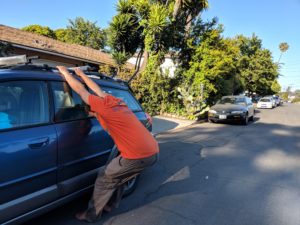
The simple act of hanging from an overhead object not only decompresses the lower spine, but also decompresses the shoulder joints in an overhead position. This helps reduce those paddling-based shoulder impingements.
Surfer Self Massage: Wave Goodbye to Tension
There’s a reason it’s recommended that beginners use foam boards without fiberglass coatings: they are more forgiving to the surfer and less likely to cause damage to both the the surfer’s body or the board, if the board hits the surfer (say, in the head), or the surfer hits the board (say, with their knee).
Similarly, when it comes to self-massage tools, it is recommended to default to using softer, more forgiving objects, in order to prevent unnecessary bangs and bruises, which is why the Roll Model® Therapy Balls are a soft, forgiving dense foam rubber.
The Tune Up Fitness YouTube channel has a playlist of Roll Model Method techniques, which will provide you with the basic framework for the different ways you can use a massage tool on your tissues.
But some specific areas with a high likelihood of helpfulness include the following:
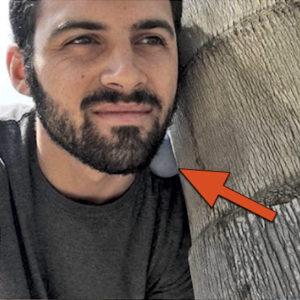

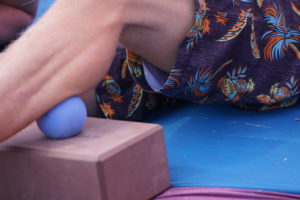
I hope that you’ve found some solid inspiration here to take care of your body at least as well as you take care of your board and wetsuit.
As with surfing, there is a learning curve to activities like stretching and self-massage. Once you’re familiar with the basic tools and techniques at your disposal, you can begin to more easily adapt them to your lifestyle and wave-sliding routines. The more time and effort you invest in becoming comfortable with the nuances of these activities, the better suited you become to react to the ever-changing environments you encounter, in the water and underneath your own skin.











I really like the practical example you gave of hanging from your car as a warm up exercise to surfing. I don’t surf but do paddle. So many of my friends have sustained shoulder injuries and I believe there is a relationship between not warming up appropriately. While I love the yoga tune up balls, while you are on the sand other exercises are a better fit. I also like your shoulder movements which seem similar to Jill Miller’s Pranic bath exercises. I plan to implement these pre-exercise routine as I hope to be out of the water for a lifetime and not get a shoulder impingement injury.
I live in Florida where surfing is really popular. I think if you’ve never surfed it’s hard to understand the impact and intensity of it. From the movement itself, to what nature says goes, to the heat, etc. I love surfing for fun, I am not good at all haha. I have many friends who have surfed their entire lives and a few of them have severe shoulder issues from years of wear and tear, along with lack of care or knowing how to move, stabilize, or stretch. These types of blogs are beyond helpful from the surfer to the teacher, thanks!
I have surfed for 20 years and now at age 50 am determined to keep myself strong and mobile to continue to surf as long as I can! The rolling techniques and low back decompression you mentioned are key for taking care of body parts overused, tight and tired from surfing. Thanks for sharing.
Thanks for the article. I love rolling in the wild and new inspirations on how to do this.
I really enjoyed this article from a “smaller sport” perspective. I haven’t surfed in a while, but I aggravate the same muscles/joints playing water polo or swimming (pool or open water). We are all so busy and always rushed…I think as a society we try to cram too many things in all at once and that leads to skipping things like warm up, cool down, self care, meditation what have you. It’s a good reminder to take that extra two/three steps to ensure a good workout/ride so that we want to do it again. If we get injured, or are sore/stiff from our activity, we are less likely to participate as quickly. Keeping ourselves all tuned up is important to continued pain free, enjoyable, fun activity!
This article offered very simple, concrete tips for pre-surf and post-surf. I’ll bring these next time I go out, and share them with my surfer friends.
The more I learn about surfers and the common aches and pains they experience, the more inspired I am to help spread this knowledge to get even more people stoked on the YTU therapy techniques!!!
I have a goal to lead yoga & surf retreats, and I’m positive that everything I’m learning in YTU will be embedded into what I share, offer, teach and use in my own self-care practice.
I love the way you weaved the roll method techniques into assisting these lightly painful areas that were keeping you and your friends from enjoying another peaceful form of exercise and enjoyment. A few small areas to roll out on and some exercises and stretching beforehand and its a brand new day!!! awesome 🙂
I love this paragraph: Similary, if you are a surfer or whatever, your body requires regular maintenance because of the adverse effects of surfing ontt he muscles, joints, bones and fasci a. Restaurative practives, including movement, massage and constructive rest are good ways to preserve the life of your most irreplaceable equipement- your body!
Hi, I really like how you draw parallels between rolling and surfing, take care of your body as you do of your board, soft balls are softer to your body as is a soft board! Also very informative, thanks.
Our entire family surfs and I can not wait to pass this well detailed article on to all of them. My husband and I are in our 50’s and well aware of aches and pains and work toward prevention. For us this is extremely helpful. Our children, all in their mid 20’s need to practice proper maintenance so they can continue to enjoy this wonderful sport for the rest of their lives. Thank you!
Spot on! I appreciate you framing the taking care of one’s body as necessary maintenance. Passing the techniques you highlighted along to my husband (and incorporating them myself) so that he can incorporate them into his own maintenance program.
Thank you for this inspiration. Max! I am not a surfer, but I really like the idea do adapt YTU techniques to support other activities, use cars and palmtrees.
Awesome ! I’m not a surfer but I am a paddleboarder, kayaker and canoeist with all of the aches and pains that you mention. I love that you recommend taking care of your body in the same way that you take care of your gear. I’m inspired to offer Therapy Ball workshops for surfers and paddlers!
Hanging is my favorite — spinal traction yummmm!
Great information and love how YTU is easily applied and relevant for all sorts of activities and athletes. My husband also surfs and would be able to relate and find these exercises and therapeutic techniques to be very helpful. Thank you for sharing and applying YTU in such a wide spectrum of many different practices!
I have only surfed a few times, but this is great advice for the future! Sounds like good exercises for many other activities too!
This is so great! My husband surfs and complains about the same areas of tightness. I love the reminder to take care of you body just like you would take care and rinse out your wet suit so it doesn’t get damaged! The pre-surf shoulder circles are a great idea to soften the tissues and awaken the shoulder girdle before paddling. Hanging off the racks of the car to decompress the spine to prevent further compression in the low back is a wonderful idea. Thank you for sharing!